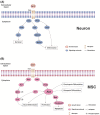Nerve growth factor (NGF) and NGF receptors in mesenchymal stem/stromal cells: Impact on potential therapies
- PMID: 33586908
- PMCID: PMC8235142
- DOI: 10.1002/sctm.20-0290
Nerve growth factor (NGF) and NGF receptors in mesenchymal stem/stromal cells: Impact on potential therapies
Abstract
Mesenchymal stem/stromal cells (MSCs) are promising for the treatment of degenerative diseases and traumatic injuries. However, MSC engraftment is not always successful and requires a strong comprehension of the cytokines and their receptors that mediate the biological behaviors of MSCs. The effects of nerve growth factor (NGF) and its two receptors, TrkA and p75NTR, on neural cells are well studied. Increasing evidence shows that NGF, TrkA, and p75NTR are also involved in various aspects of MSC function, including their survival, growth, differentiation, and angiogenesis. The regulatory effect of NGF on MSCs is thought to be achieved mainly through its binding to TrkA. p75NTR, another receptor of NGF, is regarded as a novel surface marker of MSCs. This review provides an overview of advances in understanding the roles of NGF and its receptors in MSCs as well as the effects of MSC-derived NGF on other cell types, which will provide new insight for the optimization of MSC-based therapy.
Keywords: P75NTR; TrkA; cellular therapy; mesenchymal stem/stromal cell; nerve growth factor.
© 2021 The Authors. STEM CELLS TRANSLATIONAL MEDICINE published by Wiley Periodicals LLC on behalf of AlphaMed Press.
Conflict of interest statement
The authors declared no potential conflicts of interest.
Figures

Similar articles
-
Nerve growth factor survival signaling in cultured hippocampal neurons is mediated through TrkA and requires the common neurotrophin receptor P75.Neuroscience. 2002;115(4):1089-108. doi: 10.1016/s0306-4522(02)00539-0. Neuroscience. 2002. PMID: 12453482
-
Type I interferons up-regulate the expression and signalling of p75 NTR/TrkA receptor complex in differentiated human SH-SY5Y neuroblastoma cells.Neuropharmacology. 2014 Apr;79:321-34. doi: 10.1016/j.neuropharm.2013.12.002. Epub 2013 Dec 11. Neuropharmacology. 2014. PMID: 24333329
-
Differential actions of nerve growth factor receptors TrkA and p75NTR in a rat model of epileptogenesis.Mol Cell Neurosci. 2005 Jun;29(2):162-72. doi: 10.1016/j.mcn.2005.02.007. Mol Cell Neurosci. 2005. PMID: 15911341
-
NGF and ProNGF: Regulation of neuronal and neoplastic responses through receptor signaling.Adv Biol Regul. 2015 May;58:16-27. doi: 10.1016/j.jbior.2014.11.003. Epub 2014 Nov 20. Adv Biol Regul. 2015. PMID: 25491371 Free PMC article. Review.
-
The role of nerve growth factor and its receptors in tumorigenesis and cancer pain.Biosci Trends. 2014 Apr;8(2):68-74. doi: 10.5582/bst.8.68. Biosci Trends. 2014. PMID: 24815383 Review.
Cited by
-
Correlations Between the Expression of Stromal Cell Activation Related Biomarkers, L-NGFR, Phospho-ERK1-2 and CXCL12, and Primary Myelofibrosis Progression.Pathol Oncol Res. 2022 Mar 14;28:1610217. doi: 10.3389/pore.2022.1610217. eCollection 2022. Pathol Oncol Res. 2022. PMID: 35356507 Free PMC article.
-
Therapeutic Potential of Mesenchymal Stem Cells in the Treatment of Epilepsy and Their Interaction with Antiseizure Medications.Cells. 2022 Dec 19;11(24):4129. doi: 10.3390/cells11244129. Cells. 2022. PMID: 36552892 Free PMC article. Review.
-
Prospects for the use of olfactory mucosa cells in bioprinting for the treatment of spinal cord injuries.World J Clin Cases. 2023 Jan 16;11(2):322-331. doi: 10.12998/wjcc.v11.i2.322. World J Clin Cases. 2023. PMID: 36686356 Free PMC article. Review.
-
Intra-individual variability in the neuroprotective and promyelinating properties of conditioned culture medium obtained from human adipose mesenchymal stromal cells.Stem Cell Res Ther. 2023 May 11;14(1):128. doi: 10.1186/s13287-023-03344-1. Stem Cell Res Ther. 2023. PMID: 37170115 Free PMC article.
-
The Role of Mesenchymal Stromal Cells and Their Products in the Treatment of Injured Spinal Cords.Curr Issues Mol Biol. 2023 Jun 16;45(6):5180-5197. doi: 10.3390/cimb45060329. Curr Issues Mol Biol. 2023. PMID: 37367078 Free PMC article. Review.
References
-
- Dominici M, Le Blanc K, Mueller I, et al. Minimal criteria for defining multipotent mesenchymal stromal cells. The International Society for Cellular Therapy position statement. Cytotherapy. 2006;8:315‐317. - PubMed
-
- Pittenger MF, Mackay AM, Beck SC, et al. Multilineage potential of adult human mesenchymal stem cells. Science. 1999;284:143‐147. - PubMed
-
- Zuk PA, Zhu M, Mizuno H, et al. Multilineage cells from human adipose tissue: implications for cell‐based therapies. Tissue Eng. 2001;7:211‐228. - PubMed
-
- Toma JG, Akhavan M, Fernandes KJ, et al. Isolation of multipotent adult stem cells from the dermis of mammalian skin. Nat Cell Biol. 2001;3:778‐784. - PubMed
Publication types
MeSH terms
Substances
LinkOut - more resources
Full Text Sources
Other Literature Sources

